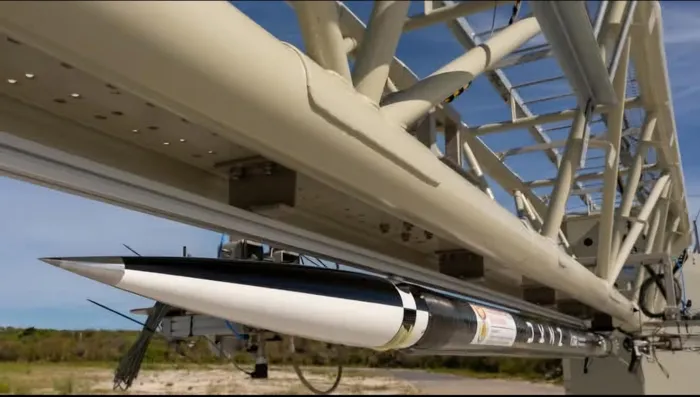UKZN Aerospace Institute launches advanced rocket facility

The Phoenix-1D hybrid rocket on the launch gantry before its test flight in December 2024 at the Denel Overberg Test Range in the Western Cape.
Image: UKZN
The University of KwaZulu-Natal (UKZN) is making huge strides in aerospace technology.
The Aerospace Systems Research Institute (ASRI) has released the official video of their successful 2024 Phoenix 1D and 1E sounding rocket launch campaign.
The campaign coincided with the official opening of ASRI’s new suborbital sounding rocket launch facility.
The launch gantry was officially unveiled by the Deputy Minister of Science, Technology and Innovation (DSTI), Nomalungelo Gina, at the Denel Overberg Test Range in the Western Cape on December, 3, 2024.
Funded by the DSTI, the facility is a first for South Africa and a landmark achievement in the advancement of aerospace technology and innovation in South Africa.
Director of ASRI, Prof Mike Brooks said the new launch gantry has a state-of-the-art aiming and control system to allow the boom to rotate through 360 degrees in the horizontal plane, while also enabling elevation up to the vertical position. This permits pinpoint aiming accuracy in any direction and fast adjustment to account for factors like changes in wind direction on launch days.
Standing as tall as a six-story building when vertical, the boom can be lowered into the horizontal position during loading of the rocket on to the rail as well as for fitting of ground support systems to enable fueling and the launch of the vehicle.
Prof Brooks added that the facility is equipped for advanced rocket testing, propulsion system development and flight-testing new technologies. It also supports research in aerospace innovation, ensuring safe and efficient operations.
“The facility is designed to enable suborbital sounding rocket missions into the high atmosphere and beyond into space. Many countries use sounding rockets to conduct research related to atmospheric physics, radiation and magnetism in regions that are too high for balloons and too low for orbiting satellites,” said Prof Brooks.
“Sounding rockets help advance our understanding of the Earth and its atmosphere but they are sizeable vehicles and need a purpose-built gantry from which to launch. The new facility makes it possible to launch ASRI’s smaller Phoenix hybrid rockets that reach a height of around 18km and are used for training young engineers. It can also accommodate much larger commercial sounding rockets that achieve altitudes above 200km, which is well into space.”
ASRI envisions the facility as a cornerstone for advancing South Africa’s national priorities, including economic growth, job creation and skills development. By fostering innovation in aerospace technology, the facility will attract investment, stimulate local industries and open new markets, said Prof Brooks. He added that it is designed to create highly skilled jobs while offering training opportunities that equip the next generation of engineers and scientists. Through these efforts, the facility will contribute significantly to positioning South Africa as a global leader in space exploration and technological innovation.
“Having a local facility from which to launch such rockets will act as a catalyst to bring rockets to South Africa for scientific missions. Importantly, it will also catalyse the local aerospace industry to develop a South African sounding rocket, as well as the payloads, on board sensors and subsystems that go into these advanced machines. These activities will stimulate the South African’s aerospace industry, creating new economic opportunities for the local advanced manufacturing industry,” said Prof Brooks.